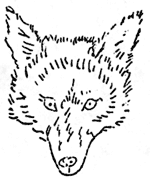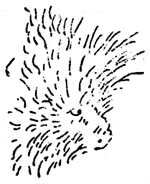|
Volume IV No. 1 - July, 1931
Protection For The Coyotes
By Frank Solinsky

Many campers, while gathered around their evening fires, have been
thrilled and held spellbound by an eerie call. The uninitiated conjures
images of an attack by ferocious beasts but to the woodsman it is the
wild and beautiful bark of a coyote.
Recently five coyote pups were found in the woods about two miles
below Government Camp, by two of the Beetle Control men. The men played
with the pups, which were about a month old, for half an hour and then
left them unharmed. The den was under a large log and in front of the
den was a dead porcupine. The coyote has the enviable ability of being
able to kill a porcupine without injury to himself.
Possibly it will be remarked that since the coyote is a pest, the
pups should have been destroyed. Although such is the practice in some
of the parks, the authorities here at Crater Lake feel that the coyote
is an integral part of the woods and should be protected. In fact, the
coyote almost balances his good with his bad, for although he kills
grouse and other birds and small animals, he also preys on the
destructive porcupines, gophers and rabbits.

Pacific Belt Of Volcanic Activity
By W. Layton Stanton, Jr., Ranger Naturalist
How many of us realize that Crater Lake lies in a belt of volcanic
activity which entirely circles the Pacific Ocean? In the far north
there are many evidences of volcanic eruption along the Aleutian
peninsular of Alaska. This zone curves southward and extends along the
western border of North America, South America and then westward across
the southern Pacific Ocean. Many of the south sea islands, all of which
owe their origin to volcanic eruptions, lie in this belt. The same
conditions exist in the East Indies and along the eastern margin of
Asia, thus completing the circle. Although the remnant of ancient Mount
Mazama is but one of many thousands of volcanic peaks occurring in this
zone, it is unique in that nowhere else is there found a lake, nestled
in a crater or caldera, which can compare with our own Crater Lake.
Just what causes this great volcanic belt, science does not know.
It must represent a zone of weakness in the crust of the earth through
which molten rock and gases are able to reach the surface. But how may
we explain the location of this relatively weak zone? That is another
answered question. Some authorities believe that the weight of the
ocean water pressing down on the ocean bottom forces subsurface material
to either side, much as a block of wood might do if pressed down into a
mass of heavy mud. This action might be expected to push up mountains
along the continental margins and force molten rock and gas through the
crust of the earth.
We should remember that Crater Lake and Mount Mazama, although
magnificent and awesome in themselves, are expressions of some great
system of forces which are continually at work in shaping our earth.
| 
